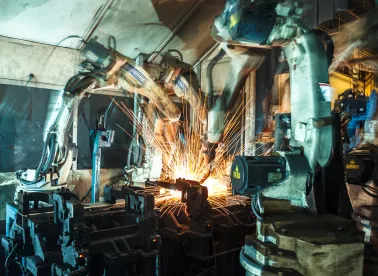In recent weeks we saw Canada, Mexico and the United States present their respective positions and legal arguments, often in sharply worded exchanges, about how the Auto Core Parts rules of origin under the U.S.-Mexico-Canada Agreement (USMCA) should be interpreted. It is a high-stakes issue because assembly operations for vehicles and their “Core Parts” (engine, transmission, etc.) inevitably involve lengthy bills of materials with components from many countries, and what is being disputed is whether Core Parts once found to meet the USMCA requirements to be “originating” can then have their value counted as originating value (i.e., “rolled up”) in the calculation of the regional value content (RVC) of the vehicle as a whole.
The USMCA changed NAFTA to impose a series of new requirements in the auto sector, among which are the following:
-
The specified Core Parts need to be originating viewed separately from the vehicle as a whole
-
There must be a sufficient level of North American-sourced steel
-
There must be a sufficient level of North American-sourced aluminum
-
There must be a sufficient level of labor content value at wages of US$16 per hour or above
The crux of the issue in the current Dispute is whether a producer, after applying the Core Parts rules and determining its Core Parts are originating, can then treat them as originating in the vehicle RVC calculation. In particular, Article 3 of the Auto Appendix to Chapter 4 of the USMCA sets forth in paragraphs 7, 8 and 9 four alternative methodologies a producer can use to determine if its Core Parts are originating. The United States contends that these four alternatives are available for meeting the requirement that the Core Parts be originating, but that when doing a vehicle RVC calculation only the first of the four alternatives (found in paragraph 8.a) can be used.
Canada and Mexico point out that Auto Appendix Article 3, paragraph 9 states explicitly that if the RVCs of the Core Parts (which are listed in Table A.2 of the Auto Appendix) meet the required threshold under one of the alternatives “then each Party shall provide that all parts under Table A.2 of this Appendix are originating and the passenger vehicle or light truck will be considered to have met the requirement under paragraph 7.” They note that this provision clearly states that the Core Parts not only meet the requirement of paragraph 7 but are also “originating,” a term which has a single definition in the USMCA. They also point out that there is nothing anywhere in the USMCA text to suggest that the meaning of “originating” changes from one part of the USMCA to another. Once found to be “originating,” a Core Part or a Super Core should, they argue, contribute to the vehicle RVC just like any other “originating” component of the vehicle.
The U.S. response consists of essentially two arguments:
-
The structure of Article 3 of the Auto Appendix and the accompanying Tables suggest that the test of whether Core Parts are originating should be considered as separate from how the vehicle RVC calculation is done. Canada and Mexico respond to this argument by saying essentially “separate or not, the USMCA says in paragraph 9 that Core Parts that meet the test not only meet the paragraph 7 requirement but are also ‘originating,’ and there is no qualification in paragraph 9 or elsewhere that limits them to being originating for only one purpose and not others.” Core Parts that meet the test are, simply, “originating,” with all that normally implies. It seems fair for Canada and Mexico to ask: If the United States did not intend a Core Part found to meet the test in paragraphs 7 to 9 also to be “originating” for the vehicle RVC, then why did it agree to the text in paragraph 9 which states explicitly “that all parts under Table A.2 of this Appendix are originating” when they meet one of the alternative tests? Indeed, on the U.S. interpretation, it seems that the words “that all parts under Table A.2 of this Appendix are originating” would become surplusage, violating the canon of statutory construction that in determining the ordinary meaning of a statute, treaty or regulation, effect must be given to all the words of the text if possible.
-
The United States also argues that, if Canada’s and Mexico’s interpretation were adopted, the net effect of the USMCA auto rules of origin would be to leave a loophole that would require much less North American content than otherwise, which was not the parties’ intent. Canada and Mexico, however, point to various ways in which the higher RVC under USMCA (75% vs. 62.5% under NAFTA) still has a significant impact on auto and auto parts qualification and is, moreover, accompanied by new USMCA requirements for steel, aluminum and labor value content. Clearly the USMCA has imposed many new content requirements, and the agreement that was made included all kinds of trade-offs. The net effect was certainly to increase North American content requirements in many respects. Canada and Mexico also note that it is not the job of the Disputes Panel to rewrite text in order to promote one party’s policy objective that was not actually negotiated in the agreed USMCA text.
The Panel asked many questions seeking to clarify the overall operation of the Core Parts and vehicle RVC calculations and how they relate to the USMCA text. At the conclusion of the hearing, the Chair announced that a draft decision will be prepared by October 12 and that a final decision will be issued by November 10.
The microphone had barely been switched off at the hearing before the U.S. International Trade Commission announced that it was launching an investigation into the economic impact and operation of the automotive rules of origin in the USMCA, with a public hearing conveniently scheduled to take place on November 3, just a week before the Disputes Panel is to issue its final decision in the pending case. The political pressure around these issues seems sure to continue in full force for the foreseeable future.



 />i
/>i

